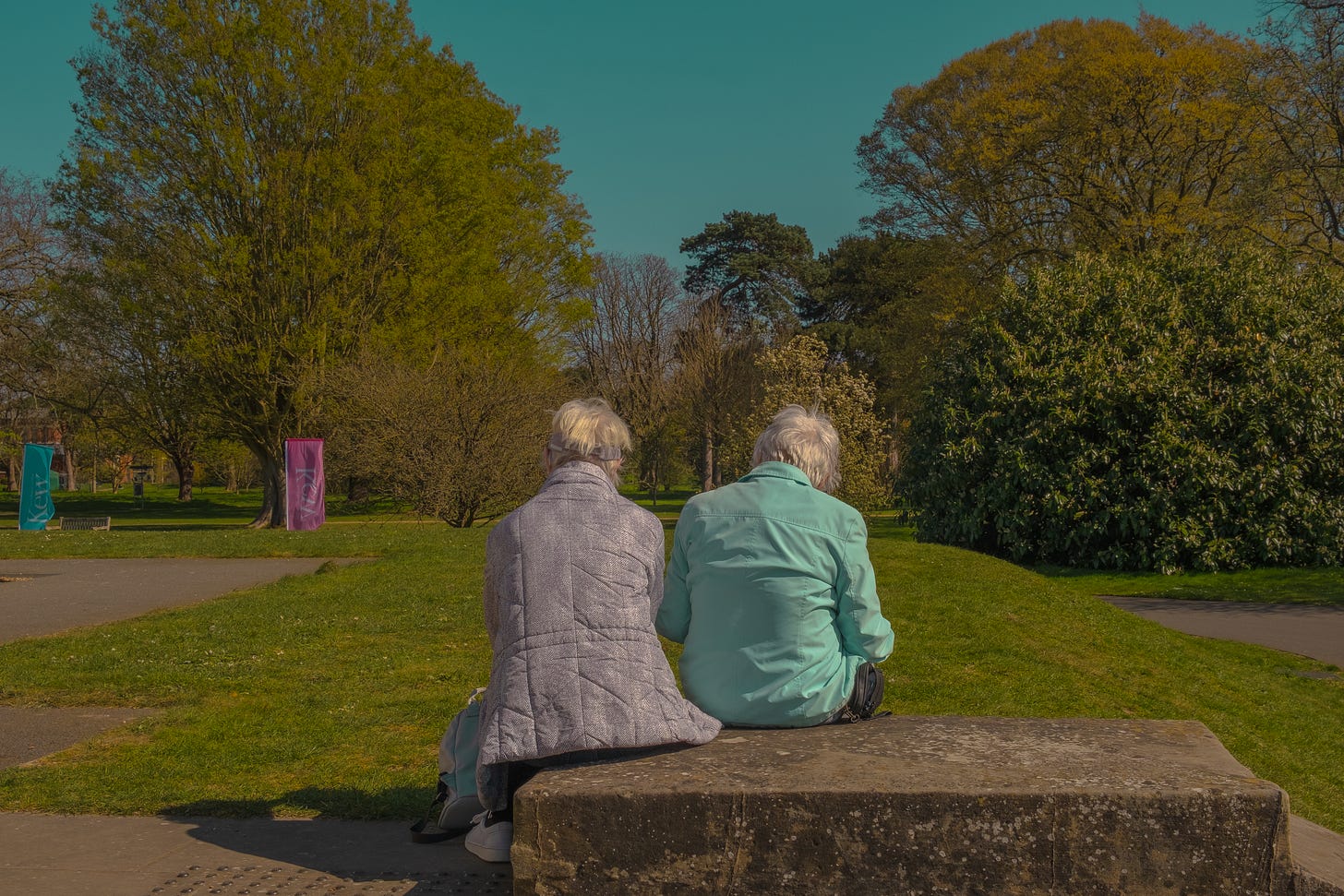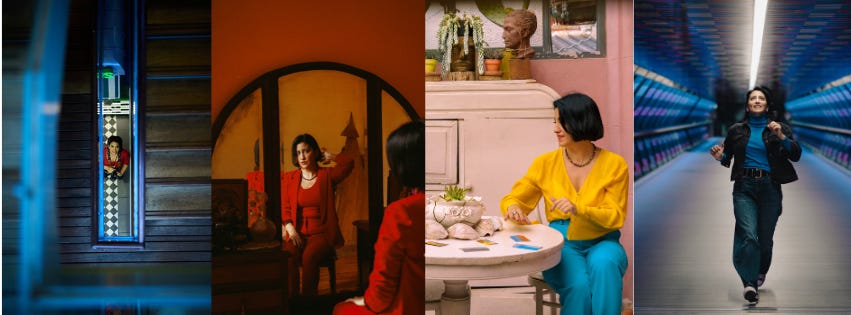cómo seguir creando todos los días
Scroll down for the English version
(Versión en inglés más abajo)
Inspirate Podcast & Newsletter.
No esperar la inspiración. Caminar con ella.
Me hicieron esta pregunta muchas veces:
¿Qué hacés cuando no estás inspirada?
Y mi respuesta sigue siendo la misma: no la espero. Me muevo.
Salir a la calle con la cámara no siempre es un acto épico. A veces no veo nada especial. A veces me frustro. Pero incluso en esos días, algo se activa cuando camino con atención. Cuando dejo que la mirada me guíe, sin exigencias.
Recuerdo una vez que salí cargada como nunca: además de la cámara, llevé el trípode, mis acuarelas portátiles, el cuaderno de bocetos y, por si fuera poco, mi diario—ese donde también escribo estas newsletters.
La mochila pesaba tanto como las expectativas que llevaba encima. Terminé con la espalda contracturada… y sin una sola foto.Así que me rendí. Me tiré en el pasto, simplemente a mirar el cielo y el paso de las nubes. Sin buscar nada. Sin hacer nada.
Horas después, ya liviana de pensamientos, me puse a pintar. Algo en la luz, en unas flores, en la forma en que la gente se sentaba, el verde del césped, todo eso me llamó. También escribí una reflexión ahí mismo. Y volví a casa sin una gran obra, pero con una sensación de conexión profunda.

5 ideas prácticas para crear sin esperar inspiración
1. Caminá sin propósito, pero con atención.
John Cage – compositor vanguardista
Cage solía caminar por el bosque o sentarse en silencio a escuchar los sonidos del entorno. Decía que “si escuchás lo suficiente, el mundo empieza a componer por vos”. Para él, el acto de atención era en sí mismo creativo.
Observá reflejos, luces raras, sombras que no encajan.
Lo que no entendés puede ser tu próximo disparador.
2. Hacelo igual, aunque no sepas por qué.
Leonora Carrington – pintora surrealista
Creaba escenas extrañas sin preocuparse por entenderlas en el momento. Su mundo onírico y simbólico nació de dejarse llevar por lo instintivo. Con el tiempo, esas imágenes revelaron capas más profundas.
Sacá la foto, pintá el trazo, escribí la frase aunque no tenga sentido.
A veces el sentido aparece después.
3. Permitite el vacío creativo.
Georgia O’Keeffe – pintora
Se retiró al desierto de Nuevo México buscando silencio e introspección. En esos períodos sin producción constante, desarrolló una mirada profunda sobre el paisaje y el tiempo. El espacio vacío nutrió su obra más reconocida.
La pausa también crea.
No todo tiene que ser productivo.
4. Cambiá de medio.
David Bowie – músico y performer
Cuando sentía que se repetía, cambiaba de entorno, se disfrazaba, escribía letras con el método del “recorte aleatorio” (cut-up technique). Se obligaba a sí mismo a salir del patrón y jugar desde lo desconocido.
Cuando no saco fotos, pinto.
Cuando no pinto, escribo.
La creatividad no es lineal: se mueve por otros caminos.
5. Dejá espacio para lo inexplicable.
Saul Leiter – fotógrafo callejero
Pionero en el uso expresivo del color, Leiter no salía a buscar imágenes claras. Deambulaba sin objetivo, con la cámara lista para registrar lo que lo conmoviera: reflejos en un vidrio, lluvia sobre un paraguas rojo, un gesto fugaz. No buscaba entender. Solo mirar.
Sentir algo es suficiente.
No todo arte necesita explicación.
Fotografiar como forma de habitar
No salgo a buscar “la foto”. Camino con la cámara como quien lleva un cuaderno. Lo uso para registrar lo que me mueve, aunque no lo entienda. Puede ser una sombra rara, una mirada fugaz, una explosión de color.
Algo me llama. Y le presto atención.
Eso también es habitar el mundo.
No solo transitarlo.

¿Qué te dejo hoy?
Si estás en un momento sin inspiración, sin certeza o sin rumbo…
Quizás lo que necesitás no es una respuesta.
Sino dar un paso, cualquier paso, y confiar en lo que aparezca.
“A veces, cuando suelto el control, es cuando las ideas más auténticas aparecen.”
Si te interesa leer más sobre mi proceso creativo y mi mirada sobre la fotografía, te comparto con alegría la entrevista que me hicieron desde Postcards and Pictures, un blog de fotografía de Londres, podés leerla completa desde aquí: “The Intuitive Art of Street Photographer Eugenia Llanez”
Con cariño,
Euge
English version:
Don’t Wait for Inspiration. Walk with It.
What I learned carrying a heavy backpack, no photos, and a moment of stillness.
What do you do when you’re not inspired?
People have asked me this many times.
And my answer is always the same: I don’t wait for inspiration. I move.
Walking out with a camera isn’t always epic. Some days I see nothing special. Some days I get frustrated. But even on those days, something shifts when I walk with attention. When I let my gaze lead the way, without pressure.
A real story from my own walk
I remember this one time I went out more loaded than ever.
Camera? Yes.
Tripod? Yes.
Portable watercolors, sketchbook, and—just in case—my diary (the same one I write this newsletter in).
My backpack was as heavy as the expectations I carried.
By midday, I had back pain… and not a single photo.
So I gave up. I lay down on the grass. Just to look at the sky and the passing clouds.
No searching. No doing.
A few hours later, lighter in my body and mind, I started painting. Something about the scene—the light, the flowers, people sitting quietly on the grass—called me. I painted. I took notes. I breathed. And I came home not with a “great work”, but with a sense of deep connection.

5 practices to create without waiting for inspiration
1. Walk without purpose, but with attention.
John Cage – avant-garde composer
Cage used to walk in the woods or sit still, just listening to ambient sound.
He believed that “if you listen long enough, the world starts composing for you.”
Notice reflections, weird lights, odd shadows.
What you don’t understand might be your next creative spark.
2. Do it anyway, even if you don’t know why.
Leonora Carrington – surrealist painter
She painted bizarre scenes without trying to understand them. Her instinctive work revealed deeper meaning over time.
Take the photo. Paint the line. Write the sentence.
The meaning can come later.
3. Allow the creative void.
Georgia O’Keeffe – painter
She retreated to the deserts of New Mexico seeking silence. In that stillness, her deepest insights on landscape and time emerged.
Pauses also create.
Not every moment must be productive.
4. Switch mediums.
David Bowie – musician and performer
When he felt stuck, he changed locations, personas, and even used random cut-up words to write lyrics. He pushed himself into discomfort to find something new.
When I’m not photographing, I paint.
When I don’t paint, I write.
Creativity moves in non-linear paths.
5. Leave space for the inexplicable.
Saul Leiter – street photographer
A pioneer in color photography, Leiter wandered without a goal. His camera ready, he captured moments that simply moved him: a red umbrella, rain on a window, a fleeting expression.
Feeling something is enough.
Not all art needs an explanation.
Photographing as a way of inhabiting the world
I don’t go out looking for the photo.
I walk with my camera the way others carry a notebook.
To record what moves me—even if I don’t know why.
Maybe a strange shadow. A fleeting look. A splash of color.
Something calls me. And I pay attention.
That too, is living in the world.
Not just passing through it.

What do I leave you with today?
If you’re feeling uninspired, unsure, or stuck…
Maybe what you need is not an answer—
but a single step. Any step.
And trust what shows up.
“Sometimes, it’s when I let go of control that the most authentic ideas appear.”
If you're curious about my creative process and my thoughts on photography, I’m happy to share this interview from the London-based blog Postcards and Pictures.
📎 Read the full interview here:“The Intuitive Art of Street Photographer Eugenia Llanez”
With love,
Euge





